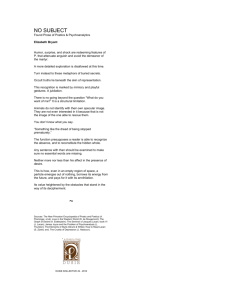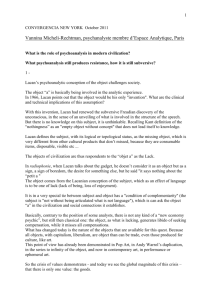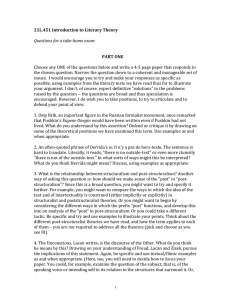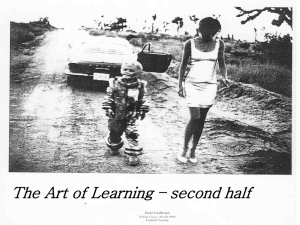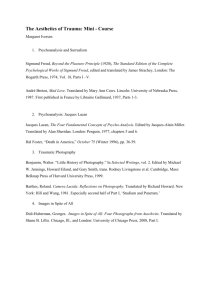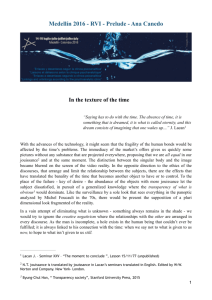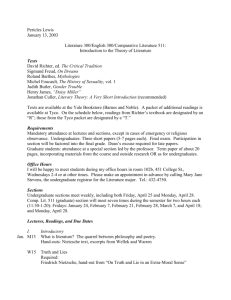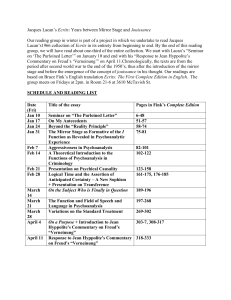: “ ”
advertisement
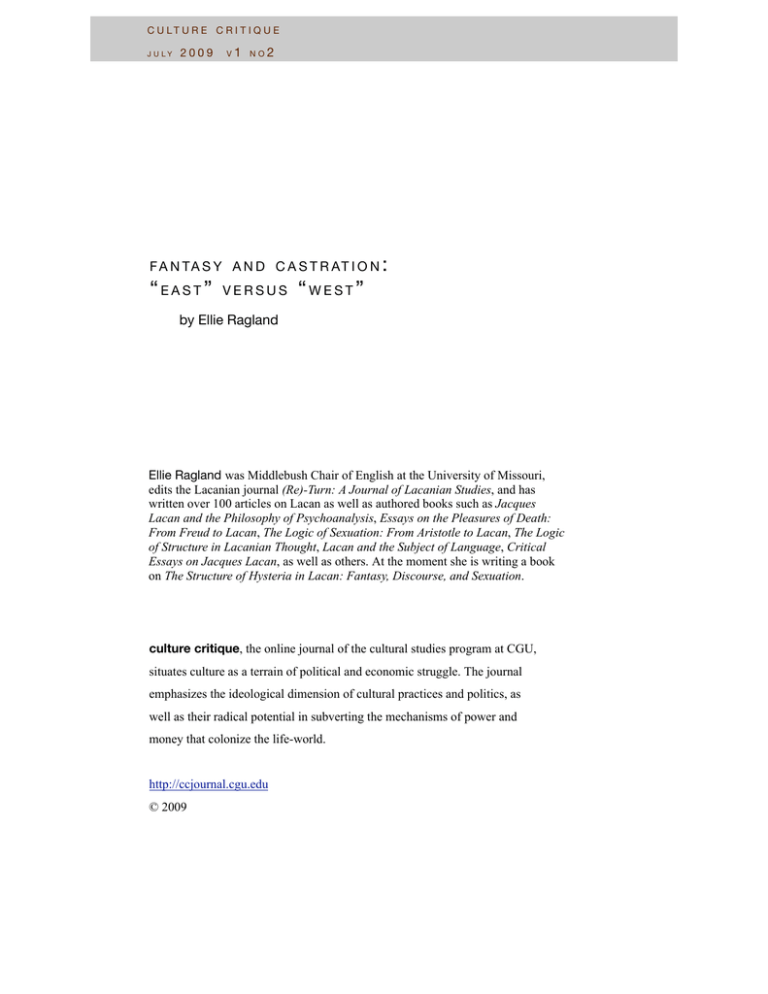
C U LT U R E C R I T I Q U E J U LY 2009 V 1 NO 2 F A N TA S Y A N D C A S T R AT I O N : “EAST” VERSUS “WEST” by Ellie Ragland Ellie Ragland was Middlebush Chair of English at the University of Missouri, edits the Lacanian journal (Re)-Turn: A Journal of Lacanian Studies, and has written over 100 articles on Lacan as well as authored books such as Jacques Lacan and the Philosophy of Psychoanalysis, Essays on the Pleasures of Death: From Freud to Lacan, The Logic of Sexuation: From Aristotle to Lacan, The Logic of Structure in Lacanian Thought, Lacan and the Subject of Language, Critical Essays on Jacques Lacan, as well as others. At the moment she is writing a book on The Structure of Hysteria in Lacan: Fantasy, Discourse, and Sexuation. culture critique, the online journal of the cultural studies program at CGU, situates culture as a terrain of political and economic struggle. The journal emphasizes the ideological dimension of cultural practices and politics, as well as their radical potential in subverting the mechanisms of power and money that colonize the life-world. http://ccjournal.cgu.edu © 2009 & 8 /7 8 5 ( & 5 , 7 , 4 8 ( - 8 /< 9 1 1 2 2 In Jacques Lacan’s theory of the fantasy, fantasy itself organizes what we ordinarily call “reality.” To arrive at such a notion, Lacan placed the sign of castration—or lack-in-being—in the position of agent of the word.i When a child discovers that he or she is interpellated by the cultural/familial law of “no,” this gives rise to a sense of his or her not being a totality, a whole being. This experience is undergone by almost everyone throughout history and society. Those who do not accept the “law” of “no” become, structurally speaking, psychotics.ii While the matheme for the fantasy is written as(lack-in-being)!D(object of potential fulfillment), the psychotic’s experience of reality is written as6(the uncastrated subject) a[equal and equivalent to] the Other. He or she experiences his or her being as a certain subject who incarnates the Other of social law). Only the formula for fantasy places the!between the subject and its mirror other. In ordinary fantasy, various objects (things, people, ideas) are sought to fill the lack-in-being. But since the lack is a structural fait accompli, except for psychotics, the subject always ends up unfulfilled or lacking. The other side of lack is the desire that continually pushes one to go on, to seek something else. This lack is structured by the experiences of alienation which determines that there be no whole self—one is re-presented by another’s words and desires—and separation from primordial objects of fulfillment.iii This means that the object a indicates a void experience in the construction of fantasy as reality. The psychotic constructs delusion, not fantasy, because he or she believes himself or herself to be whatever he or she believes he or she is. There is no lack-in-being in psychosis, only oneness with a delusional universe. 1 & 8 /7 8 5 ( & 5 , 7 , 4 8 ( - 8 /< 9 1 1 2 2 Thus, fantasy, for most people, is the reality of constructing objects of fulfillment that they take as their sustenance and point of limit, but also as a return to reconstructing this limit in the way in which law was first represented to make a subject. Jacques Alain Miller says that “the little a is only the elaboratable kernel in a discourse, that is to say it is not real, it is only a semblant.”iv Lacan says of the object a that it comes from the droppings [chutes] which attest to the fact that the subject is only an effect of language. We have promoted them as object a. v This construction of fantasy occurs via Lacan’s rewriting of Freud’s Oedipal complex.vi The Name of the Father stands over the mother’s desire)10'and the mother’s desire stands over a question mark-", an enigma0'"regarding her own unconscious experience of castration, of taking on the lack-in-being. The result is that the Name of the Father or the “law” that imposes itself as a symptom (the sinthome in the particular) yields the cultural field of signifiers as the Other that stands over the creation of the subject as phallus (that is, desired object) to the Other)1¹[Other/phallus]).vii The psychotic does not undergo this experience of castration because he or she is one with the totally alienated Other and identifies him or herself as being the phallus desired by others instead of being the phallus created by the Other’s desire. When we take up the question of the “East” facing “West,” we have an abundance of examples through which to see this fantasized construction. For example, the “West” takes the “Eastern” woman behind the veil to be a symbol of the repression of woman as a sexual being, an emotional entity, or an intellectual presence. Woman is seen here in an uncritical leftist construction as an annihilated being to be liberated by a “Western” fantasy of the “East”.viii Of course, there is also truth to this “Western” concept insofar as “Eastern” women are oppressed, targeted by the Taliban, and by the culture in general to represent something hidden. 2 & 8 /7 8 5 ( & 5 , 7 , 4 8 ( - 8 /< 9 1 1 2 2 Yet, the reality of the wealthy “Eastern” woman is that the veil is a symbol of privacy. In her own home, behind drawn curtains, the woman removes the veil and interacts with her family and friends.ix Moreover, wealthy “Eastern” women have private beaches where they bathe in bikinis. Even more surprising is that three quarters of the money spent on “Western” designer clothes (Givenchy, Dior, Laurent, and so on) is spent by “Eastern” women who remove their veils once they arrive at a given social occasion. The fantasy that the “East” has of “Western” women is that they do not value themselves sexually and emotionally as special, as women, different from men who dwell mostly in what Lacan called the symbolic order public sphere. Here it is valuable to look at Lacan’s sexuation graphs as examples of a difference that is made between the masculine position (not gender specific) and the feminine position (not gender specific) and the differences that arise on the masculine symbolic order side as opposed to the feminine on the side of the real.x In Lacan’s sexuation graph, the masculine side of sexuation—where “Eastern” women tend to place “Western” women alongside men—abides by the logic of there being an exception to the law of castration[e[as itself the law since the exception itself[is only a myth.xi For example, God is taken as an exception to the law of castration. On the feminine side of the sexuation graph, there is no exception to the law of castration, except for the psychotic. Women are all not men. They hold the place of the same rather than that of the one different from the mother, the first identificatory object[f[But this gives rise to a paradoxical logic. A point to remember, lest one essentialize man or woman in Lacan’s sexuation is that ”since masculine or feminine fantasy identification do not correspond to biological gender, nor do they determine the gender of sexual object preference.”xii 3 & 8 /7 8 5 ( & 5 , 7 , 4 8 ( - 8 /< 9 1 1 2 2 Because all women, except psychotic ones, are castrated in not being a man—that is, in being the same in reference to which difference is measured—woman has to find her being in the logic of the particular[e[Each feminine one goes his or her own way, unlike the masculine one who conforms to the group of others under the symbolic law of castration[f[The result of this, so-called by Lacan, discordential logic is that on the masculine symbolic order side, masculine means accepting castratione, except for the psychotic. The masculine subject endures this castration by his or her links to the feminine on the side of the real. He or she is linked to the feminine as a sexual object, heterosexual or homosexual¹DThe castrated subject in the symbolic order is also linked to the real by his or her myth of an essential woman he or she fantasizes, but who does not existe¹6Ê:RPDQEDUUHGSince there is no essential woman, only fantasies of how one constructs difference as itself a third thing— masculine-feminine/difference-castration—masculine social myths, whether held by a man or a woman, reveal, rather, that there is a void in the Other, as well as a lack in the subject. “Eastern” women regarding “Western” women, see someone who gives no place to the real as a place of actual exception. The idea of an exception itself functions as a limit, as an admission that there is a need for a limit in order that law exist, in order that we not be a society of psychotics, a contradiction in terms. “Western” women are generally thought by “Eastern” women to be immoral, loose, “little” men. And in an uncritical leftist logic, one would claim that sexual liberation of women has resolved the fundamental problems of sexual being and sexual difference, even questions regarding the meaning of human existence. But the realities of life in the “West” show single parent mothers, divorced women, women who suffer having to brave the 4 & 8 /7 8 5 ( & 5 , 7 , 4 8 ( - 8 /< 9 1 1 2 2 symbolic on their own. This is not to promote, however, an idea that “Eastern” women imprisoned in their families are a model to follow. Indeed, one cannot enslave another. One might even go so far as to suggest that “Eastern”/Arabic peace depends upon the liberation of women in order that there be some acceptance of difference as equality, even if some differences remain. Yet, as Andrew Long has reminded me, Americans recently fought a war against Afghanistan in which one of their stated goals was to liberate women. If one goes a little further with these ideas, one finds in certain groups the same logic in “Western” fantasies of women that “Easterners” hold about “Western” women. In “Western” fundamentalist religious right-wing thought, woman is seen as the bearer of sin insofar as she incarnates sexual temptation. Thus, she is enjoined to cover her body with long sleeves and simple dresses and to wear her hair pulled back. She is to wear no makeup and is urged to never tempt man. She has been put under the veil, except that she does not have the escape of distinguishing between the public and private spheres, between the symbolic and the real, something the veil ensures to “Eastern” women. For example, Indian actresses are spared the public expectation that their private lives be revealed. Yet, at another level, these differences between “Eastern” and “Western” women can come down to class difference insofar as truly repressed “Eastern” women are often lower class, as are, often, the right-wing fundamentalists characterized above. But in the final analysis, both “East” and “West” construct their fantasies of women in relation to the sexual difference which Lacan always claimed created difference/castration as itself a third thing. Cultural practices become so many ways to try to understand the Oedipal construct that Lacan wrote at the end of his teaching as a void in the OtherhcastrationWhen the void in the Other appears over 5 & 8 /7 8 5 ( & 5 , 7 , 4 8 ( - 8 /< 9 1 1 2 2 castration, one confronts an incomplete logic. The)1¹einconsistent otherover the0'¹ an enigma.hmeans that we are confronted in our fantasies—“East” or “West”—withloss hlack[LLL What is law, then, if not the structural outcome of interpreting difference as sexual difference whose effects leave in its wake the seemingly normative masquerade, the neuroses (obsession and hysteria), the psychoses (paranoia, schizophrenia, and ordinary psychosis), and perversion—the categories of jouissance that arise for each person as a fantasmatic construction of the meaning of the sexual difference which, in turn, establishes imaginary myths embodied in symbolic order words and laws, both trying to interpret what lies outside themselves—the real— the logic of fantasy being its place.xiv 6 & 8 /7 8 5 ( & 5 , 7 , 4 8 ( - 8 /< 9 1 1 2 2 Works Cited: Aitel, Fazia and Michel Valentin, ed. The Veil in all its States. Missoula, MT: The University of Montana Press, 2008. Lacan, Jacques. The Seminar, Book III (1955-1956) The Psychoses, ed. by Jacques Alain Miller, trans. by Russell Grigg. New York: Norton, 1994. ---. The Seminar, Book XI, The Four Fundamental Concepts of Psycho-Analysis, ed. by Jacques Alain Miller, trans. by Alan Sheridan. New York: Norton, 1981. ---. The Seminar, Book XX (1972-1973), Encore, ed. by Jacques Alain Miller, trans. by Bruce Fink. New York: Norton, 1999. ---. “La logique du fantasme,” Autres Ecrits. Paris: Seuil, 2001. Miller, Jacques Alain. “Prologue,” in Autres Ecrits by Jacques Lacan. Paris: Seuil, 2001. Ragland, Ellie. Essays on the Pleasures of Death: From Freud to Lacan. New York: Routledge, 1995. ---. The Logic of Sexuation: From Aristotle to Lacan. Albany, NY: SUNY Press, 2004. ---. “The Masquerade, the Veil, and the Phallic Mask,” Psychoanalysis, Culture & Society, vol. 13, no. 1 (April 2008). 7 i Jacques Lacan, Le S minaire, livre XIV (1966-1967), La logique du fantasme, unedited seminar. ii Jacques Lacan, The Seminar, Book III (1955-1956) The Psychoses, ed. by Jacques Alain Miller, trans. by Russell Grigg (New York: Norton, 1994). iii Jacques Lacan, The Seminar, Book XI, The Four Fundamental Concepts of Psycho-Analysis, ed. by Jacques Alain Miller, trans. by Alan Sheridan (New York: Norton, 1981). Cf. Chapter 16. iv Jacques Alain Miller, “Prologue,” in Autres Ecrits by Jacques Lacan (Paris: Seuil, 2001), p. 8 (my translation). v Jacques Lacan, “La logique du fantasme,” Autres Ecrits (Paris: Seuil, 2001), p. 324 (my translation). vi Jacques Alain Miller, Du symptome au fantasme and de retour, Course of 1982-1983, Department of Psychoanalysis, University of Paris VIII, Saint Denis, Unedited course. vii Ellie Ragland, Essays on the Pleasures of Death: From Freud to Lacan (New York: Routledge, 1995), p. 186. viii Ellie Ragland, “The Masquerade, the Veil, and the Phallic Mask,” Psychoanalysis, Culture & Society, vol. 13, no 1 (April 2008), pp. 8-23. ix The Veil in all its States, ed. by Fazia Aitel and Michel Valentin (Missoula, MT: The University of Montana Press, 2008). x Jacques Lacan, The Seminar, Book XX (1972-1973), Encore, ed. by Jacques Alain Miller, trans. by Bruce Fink (New York: Norton, 1999), cf. Chapter 7. xi Ellie Ragland, The Logic of Sexuation: From Aristotle to Lacan (Albany, NY: SUNY Press, 2004). xii Ellie Ragland, Essays on the Pleasures of Death: From Freud to Lacan (New York: Routledge, 1995), p. 196. xiii Ibid., 192. xiv Jacques Lacan, “La logique du fantasme,” Autres Ecrits (Paris: Seuil, 2001), p. 326.
